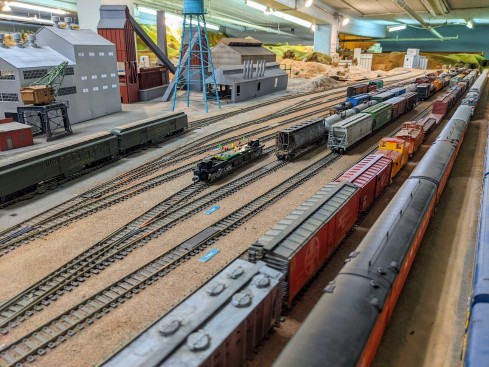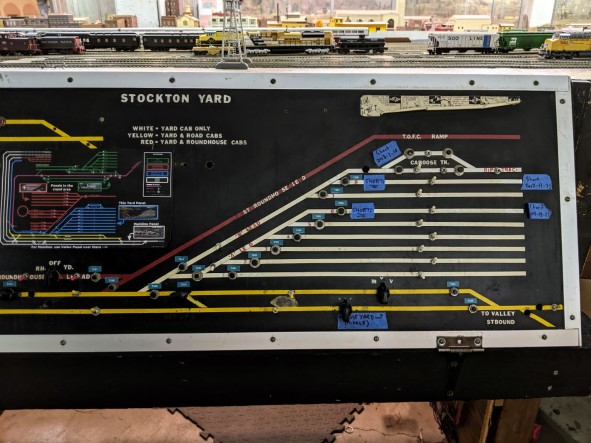The Randall Museum in San Francisco hosts a large HO-scale model railroad. Created by the Golden Gate Model Railroad Club starting in 1961, the layout was donated to the Museum in 2015. Since then I have started automatizing trains running on the layout. I am also the model railroad maintainer. This blog describes various updates on the Randall Museum Model Railroad and I maintain a separate tech blog for all my electronics & software not directly related to Randall.
2022-09-04 - An Update on Stockton Yard
Category RandallHere’s the result of an afternoon of work with Allen:
What you do not see here are the little blue tape markers that were condemning some of the yard tracks since 2017 and 2018. More on that below.
First I’ve reworked my DCC Dead Spot Detection Car, and it’s worth explaining what I did to fix its electrical pickup issues.
The base is an Athearn Genesis and one of the trucks was making a real bad contact, resulting in the LEDs blinking faster than an aluminum xmas tree. I disassembled the faulty truck, thoroughly cleaned the little metal plates that do the electrical pickup, and even had to bend them a tiny bit so that they make better contact with the wheels. Now to be fair, I read about that specific fix in the MRH Forums a while ago. It’s a known issue on these models even out of the box. Interestingly enough, before I took the whole engine apart to keep only the frame, the issue was not apparent, and the donor engine ran wheel. Likely because decoders pick up from both the front and rear trucks in parallel and in this case one of the trucks was perfect, whereas the other one had really bad intermittent pickup which the capacitors on a decoder board are designed to smooth out.
Now back to the yard. This has been the state of the yard for a little over 4 years:
Blue tape clearly “prevents” operators from using yard tracks 6 to 9.
As you can guess, the issue is with the little blue sticker labeled “shorts” on the yard tracks 6 to 9. Let’s back up to understand why these were labeled as a problem, and what we did to fix them.
Late 2017 is when Jim and I were able to access the layout after its not-quite-2-years renovation period. First thing I did back then was try all the blocks on all the panels, itemize all the work to be done, and my philosophy is “label everything now, deal with it later”. That’s what the blue tape is for. Back in 2017-12, judging by the date written on some of the blue tape, I figured out that selecting tracks 6, 7 or 8 would simply short the yard or the mainline. Why, no idea. I was just itemizing things, not fixing them.
And yes, Jim and I figured out that shorting something in the yard would sometimes short the mainline in a seemingly totally unrelated part of the layout such as Fairfield in the Valley district, which is quite far away from the yard in the topology on the layout. That was a major “WTF” moment.
Then later on 2018-2, I also figured that trying to use the caboose track at the top of the yard was shorting something. Again, label it, and deal with it later. We had 5 tracks of storage to work with and that was quite enough for a while.
The yard with some of the track “blocked” by blue tape.
That later is now…Before we didn’t care so it wasn’t much of a priority, but now Jim could use the extra space. In between, we got a serious car donation from Judy V. a few years ago and from Allan P. quite recently. These brought use some quality HO freight cars that Jim enjoys running on the layout, not to mention passenger cars and scenery that I sprinkle on the layout as time goes. So bottom line, that yard was getting crowded and we could use the other tracks.
I also remember back in 2018 crawling under the yard and looking at the turnouts, and I could see nothing obviously wrong with the wiring of the twin coils. IIRC I did label some of them with the corresponding turnout number..
Something else had happened in between: I had resolved my “yard shorts the mainline how?” WTF moment a few years ago. To make a long story short, it has to do with the power cross-feed from the “Front Yard” toggles on the Mountain and Valley panels -- a feature necessary on this old DC-layout design to power the yard interchange tracks from the corresponding mainline panels, but that is totally unnecessary now in DCC. Actually it’s not “unnecessary”, it’s counterproductive and nasty, as it means it can bridge power district boundaries (mean short in one section after another section that should have been isolated… see the issue now?) and link boosters together indirectly (e.g. yard to valley boosters). Bad stuff.
For a while, we had these in the wrong position before I spent time understanding what they were for (the benefit of inheriting maintenance on a 50-yr old layout with no documentation whatsoever)..
Eventually one day I need to remove these cross-feed power toggles -- after carefully analyzing the wiring, to make sure I don’t somehow break some major important thing, like I did 2 years ago, which took me a while to fix.
So today the work was simple: Allen and I tried every single yard track one by one. What we found:
- Lots of dirty tracks, which need cleaning, not a problem. See below for how it should be cleaned.
- All turnouts are functional. Yeah! Actually that’s a major relief.
- Only one short due to a loose wire, which we cleaned, as described below.
- As predicted, shorting every single track had no influence on a train running on the mainline.
The only “real” issue we found is a little loose wire in one of the turnouts, apparently from a closure rail power feed:
That tiny loose wire was hard to spot.
When this turnout is straight, the closure rail is powered using the polarity of the lower rail, and thus that wire has the reverse polarity of the upper rail. As soon as a car with a metal wheel drives on this, it bridges the wire with the upper rail of opposite polarity and we get a short. Luckily the fix was simply to lift that wire, cut it with flush cutters, and we used a small screwdriver to clear any debris in the gap.
The DCC Dead Sport Detection Car at work in the yard.
All that is left to do is for Jim and the Saturday Operators to clean the track yards. A drop of ATF or Rail-Zip (same thing) on the roller car and moving it back and forth a dozen times on the yard track (likely using a lot of freight buffer cars) will fix that in a short time. Also requires usage of the Walthers hand cleaning tool to wipe the rails (removes any gunk from the ATF), and especially avoiding the nasty brightboys (these scratch the rails, get stuck in turnouts, and do not help at all long term)… That’s how I got the other yards (Napa, Richmond) back in operation.




